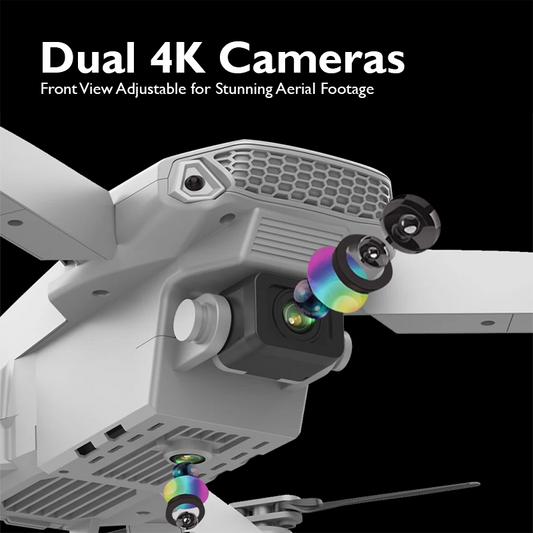The Future of Drones: Emerging Technologies

In the realm of technology, few innovations have captured the imagination and potential for transformative change quite like drones. These unmanned aerial vehicles (UAVs) have evolved far beyond their military origins and are now poised to revolutionise industries ranging from agriculture to healthcare. As we gaze into the future, it's clear that the trajectory of drone technology is set to soar to new heights, driven by a wave of emerging technologies that promise to reshape the landscape.
The Evolution of Drones

Drones, once confined to military applications, have swiftly made their mark in the commercial and consumer sectors. The advancements in battery technology, miniaturisation, and connectivity have paved the way for smaller, more agile drones that can be used for an array of purposes. From capturing breathtaking aerial photography to delivering packages at our doorsteps, drones have become an integral part of our lives.
Beyond the Horizon: Emerging Technologies

1.5G Connectivity:
One of the most significant bottlenecks in drone technology has been the limitation of communication bandwidth. Enter 5G, the fifth generation of wireless technology. With its unprecedented speed and low latency, 5G connectivity will enable drones to communicate seamlessly with each other and ground stations, opening up possibilities for real-time data transfer and enabling more complex operations. This will be crucial for applications like drone delivery and autonomous aerial vehicles.
2.Artificial Intelligence (AI):
AI is the backbone of the future of drones. Machine learning algorithms empower drones to learn from data, make intelligent decisions, and adapt to changing environments. In the context of drones, AI can be employed for autonomous navigation, obstacle avoidance, and even predictive maintenance. Imagine a fleet of drones that can collaborate, learn from each other's experiences, and continuously improve their efficiency – the possibilities are limitless.
3.Computer Vision:

The integration of computer vision into drone technology allows these devices to "see" and interpret their surroundings. This technology is pivotal for tasks such as object recognition, tracking, and even understanding the terrain. Drones equipped with sophisticated computer vision systems can be deployed for applications like search and rescue, environmental monitoring, and precision agriculture, where a keen eye from above can make all the difference.
4.Swarm Intelligence:
Inspired by nature, swarm intelligence involves the coordination and collaboration of multiple drones to perform tasks collectively. Mimicking the behaviour of swarms in nature, such as flocks of birds or schools of fish, drone swarms can accomplish tasks more efficiently and robustly than individual drones. This technology has the potential to revolutionise agriculture, as drone swarms could monitor and manage crops with unprecedented precision.
5.Edge Computing:
Traditionally, drones relied on cloud computing for processing vast amounts of data. However, this approach introduces latency issues and can be impractical in remote areas. Edge computing, which involves processing data closer to the source (on the drone itself or nearby devices), addresses these concerns. With edge computing, drones can process data in real-time, enhancing their autonomy and responsiveness.
Applications Across Industries
1.Agriculture:

In agriculture, drones equipped with AI and computer vision can survey vast expanses of farmland, assessing crop health and identifying potential issues. They can even be programmed to disperse fertilisers or pesticides with pinpoint accuracy, reducing waste and environmental impact.
2.Healthcare:

The healthcare industry stands to benefit significantly from drone technology. Drones can be used to transport medical supplies, such as vaccines and medications, to remote or disaster-stricken areas. In emergencies, drones equipped with medical equipment can provide rapid response, delivering critical supplies faster than traditional methods.
3.Infrastructure Inspection:

Inspecting infrastructure like bridges, power lines, and pipelines can be time-consuming and dangerous. Drones equipped with advanced sensors and cameras can perform these inspections more efficiently and safely. They can capture high-resolution imagery and detect potential issues, enabling timely maintenance.
4.Environmental Monitoring:

Drones play a vital role in environmental conservation by providing a bird's-eye view of ecosystems. They can monitor deforestation, track wildlife, and assess the impact of climate change. With the integration of emerging technologies, drones can contribute even more effectively to environmental preservation efforts.
Regulatory Challenges and Ethical Considerations
While the future of drone technology holds immense promise, it also raises important questions about regulations and ethics. Striking a balance between innovation and ensuring the safety and privacy of individuals is paramount. Governments and regulatory bodies are grappling with the task of developing frameworks that foster innovation while mitigating potential risks.
Ethical considerations also come to the forefront, particularly regarding privacy and security concerns. As drones become more pervasive, there is a need for clear guidelines on data collection and usage. Additionally, safeguards must be in place to prevent misuse of drone technology, ensuring that it is employed for the greater good of society.
As we navigate the skies of tomorrow, the future of drones is undeniably intertwined with a tapestry of emerging technologies. From the seamless connectivity offered by 5G to the intelligence bestowed by AI and the collective power of drone swarms, the possibilities are vast. Industries will be transformed, and new frontiers of possibility will emerge, all guided by the steady hum of propellers above.
However, this journey is not without its challenges. Striking a balance between innovation and regulation, addressing ethical concerns, and ensuring the responsible use of drone technology will be pivotal. The roadmap to the future of drones is complex, but as we stand on the precipice of this technological revolution, the horizon is filled with the promise of a world where drones contribute to a safer, more connected, and efficient future.
Explore a variety of drones at our online drone store.Happy Flying!











